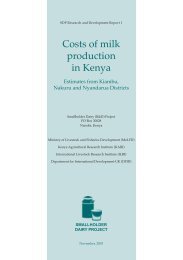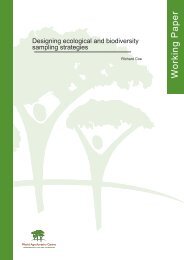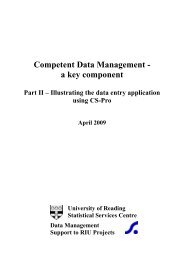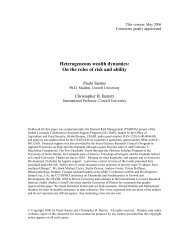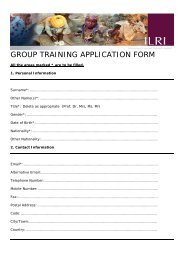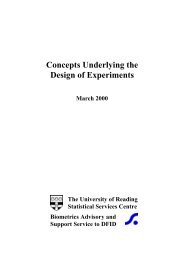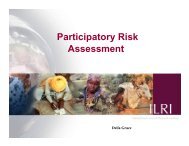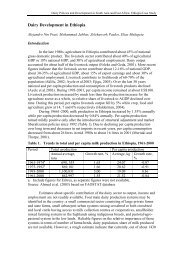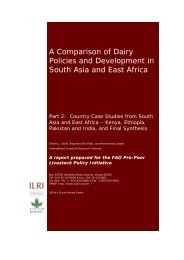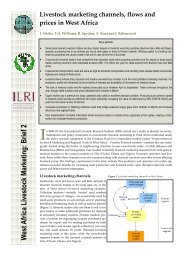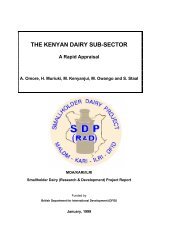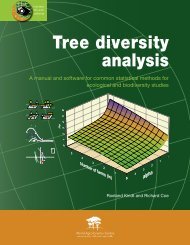Improvement of Livestock Production in Crop-Animal Systems in ...
Improvement of Livestock Production in Crop-Animal Systems in ...
Improvement of Livestock Production in Crop-Animal Systems in ...
Create successful ePaper yourself
Turn your PDF publications into a flip-book with our unique Google optimized e-Paper software.
Table 4. Value <strong>of</strong> animal products <strong>in</strong> the two AEZs <strong>of</strong> Asia (average for 1987–1989).Lowlands Uplands Per cent <strong>of</strong>Value Per cent Value Per cent Asia <strong>in</strong> bothCommodity(US$10 6 ) <strong>of</strong> Asia (US$10 6 ) <strong>of</strong> Asia zonesLarge rum<strong>in</strong>ant meat 1884.7 36.7 817.1 15.9 52.6Small rum<strong>in</strong>ant meat 842.7 23.6 349.1 9.8 33.4Milk 1354.7 6.0 4059.1 18.0 24.0Total CGIAR commodities 4082.1 13.1 5225.3 16.7 29.8Pork 9409.6 46.2 2490.7 12.2 58.4Poultry meat 2120.2 51.7 771.4 18.8 70.5Eggs 3368.9 40.7 1270.0 15.4 56.1Total non-CGIAR commodities 14898.7 45.5 4532.1 13.8 59.3Total 18980.8 29.7 9757.4 15.3 45.0Source: TAC (1994).Characteristics <strong>of</strong> the uplands• The topography is slop<strong>in</strong>g and hilly. In the Philipp<strong>in</strong>es, uplands are characterised by slopes <strong>of</strong> 8–18%(BAR 1989), which is also the def<strong>in</strong>ition used <strong>in</strong> Hunan Prov<strong>in</strong>ce <strong>in</strong> Ch<strong>in</strong>a.• The environment is fragile and resource degradation is evident. Overgraz<strong>in</strong>g and <strong>in</strong>creas<strong>in</strong>glydestructive human activities are result<strong>in</strong>g <strong>in</strong> the loss <strong>of</strong> vegetative cover, excessive run<strong>of</strong>f, <strong>in</strong>creasedsoil erosion, decl<strong>in</strong><strong>in</strong>g soil fertility and decreased agricultural production.• Shift<strong>in</strong>g agriculture is common, whilst <strong>in</strong> the wetter areas and on slopes perennial tree crops are planted.• The human population density is moderate to high. The people have less access to resources and markets,face greater isolation and <strong>in</strong>stability <strong>of</strong> production. Farmers are poorer than those <strong>in</strong> the irrigated areas,and exert considerable pressure on the natural resource base for survival.• Both annual crops (cereals, legumes, roots, vegetables) and perennial tree crops (coconut, oil palm,rubber and fruit) are grown, <strong>of</strong>ten without the <strong>in</strong>tegration <strong>of</strong> animals.• Rice yields range from only 0.9 t/ha (Cambodia) to 1.6 t/ha (Indonesia), and are the lowest <strong>of</strong> the threema<strong>in</strong> groups <strong>of</strong> rice varieties (IRRI 1993a).• Lower populations <strong>of</strong> cattle, goats and sheep are present compared with the irrigated areas and ra<strong>in</strong>fedlowlands. The numbers <strong>of</strong> native pigs and poultry are high.• Common property use by graz<strong>in</strong>g rum<strong>in</strong>ants is a major problem. In the Mekong countries, movement<strong>of</strong> cattle and common property graz<strong>in</strong>g is l<strong>in</strong>ked to shift<strong>in</strong>g agriculture whilst <strong>in</strong> the Philipp<strong>in</strong>es, it isassociated with the nature <strong>of</strong> property rights.• The area provides considerable opportunities for diversification <strong>of</strong> resource use, but specialisation andeconomies <strong>of</strong> scale are more difficult at the present time.• Equity concerns and <strong>in</strong>creased opportunities for <strong>of</strong>f-farm employment are generally greater than <strong>in</strong> thelowlands. The latter contributes significantly to total household <strong>in</strong>come.The <strong>in</strong>tegration <strong>of</strong> crops and animals <strong>in</strong> the ra<strong>in</strong>fed lowlands and uplands provides major challenges forresearch, to <strong>in</strong>clude the improved use and management <strong>of</strong> natural resources and the development <strong>of</strong>susta<strong>in</strong>able, market-orientated production systems.ConclusionsThis chapter has attempted to rationalise the classification <strong>of</strong> the AEZs by approximat<strong>in</strong>g climatic def<strong>in</strong>itions(sub-humid and humid) to those <strong>of</strong> rice technology (ra<strong>in</strong>fed lowlands and uplands) on the basis <strong>of</strong> relativesoil moisture stress. Accord<strong>in</strong>gly, for the purpose <strong>of</strong> this report the sub-humid and humid AEZs will bereferred to as the uplands and lowlands.



